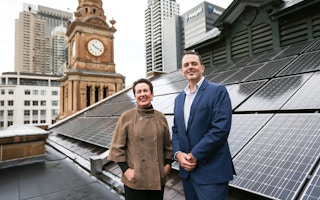The City of Sydney on Tuesday announced a target of zero net greenhouse gas emissions by 2050, and said it aims to draw half of the local area’s electricity supply from renewable sources by 2030, up from 3 per cent today.
These targets, announced in the City’s new five-year masterplan titled Environmental Action 2016-2021, are additions to those laid out in its Sustainable Sydney 2030 vision, which aims to reduce the city’s emissions by 70 per cent by 2030 compared with 2006 levels.
In the draft report, which is available for feedback and viewing online and in a public exhibition, the City — which is the local government body responsible for Sydney’s central business district and surrounding suburbs — laid out a series of actions that it will take between now and 2021 to achieve its 2030 targets as well as its net zero emissions ambition.
These include investing A$10 million to help local businesses and residents take up renewable energy, launching a challenge to encourage developers to build Sydney’s first net zero emissions building, and developing a strategy to transform waste into a valuable resource.
Clover Moore, Lord Mayor of the City of Sydney, noted in a statement that “temperatures are already increasing, and by 2070, Sydney could be up to 3 degrees (Celsius) hotter”.
“The City of Sydney is getting on with the job of slowing this dangerous warming while setting bold new targets for the future,” she added.
The report also showed that the City is on track to meet many of the targets it had set to make its own operations more sustainable and to improve the environmental performance of the area it governs.
For example, in 2014, the city government announced that it would reduce greenhouse gas emissions from its own operations by 26 per cent by the end of this year compared with 2006 levels. By last year, it had already achieved a 27 per cent cut in emissions.
The City also exceeded its targets to improve waste and resource recovery from buildings and facilities it manages. While it planned to achieve an annual resource recovery rate of 54 per cent from its assets by the end of this year, it reported that current rates are already at 56 per cent.
The report also highlighted strong progress in reducing the carbon footprint and improving resource efficiency of the City’s local government area. For example, the area’s emissions have shrunk by 19 per cent since 2014 thanks to a slew of measures to increase energy efficiency and scale up renewable energy installations.
While the City has been unable to succeed in its aim to cap annual potable water consumption at 2006 levels due to population increase and the removal of water use restrictions by the state government, it has managed to get businesses to implement water efficiency measures which collectively save more than 1 billion litres of water annually.
Despite the City’s progress, Moore noted that “we can’t do this alone — we need change at state and federal levels on outdated rules and regulations holding us back from maximising energy, water, and waste efficiencies”.
To do this, it called on the New South Wales state government to increase the minimum environmental performance standards — known as BASIX, or Building Sustainability Index — for new buildings, and asked the federal government to make electricity cheaper and cleaner, and to encourage local generation.
Moore added: “We are calling for increased climate action from all levels of government, so together, we can make a real difference on climate change.
“Cities are on the front line in the fight against climate change,” she added. “We will continue to work hard to ensure Sydney is one of the world’s leading green cities”.










